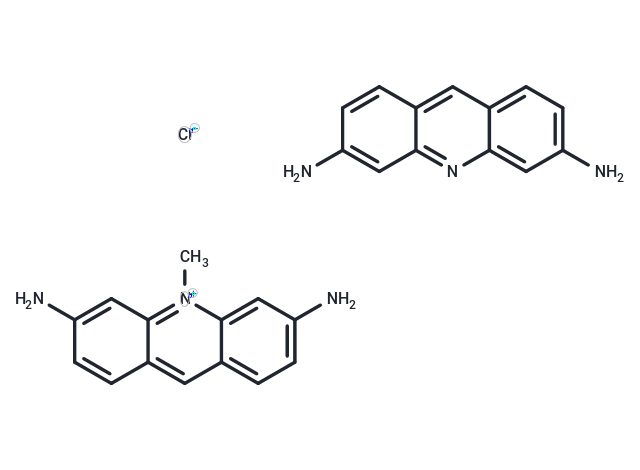Shopping Cart
- Remove All
 Your shopping cart is currently empty
Your shopping cart is currently empty

Acriflavine (Acriflavinium chloride 3,6-Acridinediamine mix) is a papain-like protease (PL(pro)) inhibitor, a fluorescent dye for labeling high molecular weight RNAs, has antimicrobial and anticancer activity, inhibits SARS-CoV-2 and other β-coronaviruses, and can be used for research on leukemia. be used to study leukemia.

| Pack Size | Price | Availability | Quantity |
|---|---|---|---|
| 50 mg | $34 | In Stock | |
| 100 mg | $47 | In Stock | |
| 500 mg | $105 | In Stock | |
| 1 g | $152 | In Stock |
| Description | Acriflavine (Acriflavinium chloride 3,6-Acridinediamine mix) is a papain-like protease (PL(pro)) inhibitor, a fluorescent dye for labeling high molecular weight RNAs, has antimicrobial and anticancer activity, inhibits SARS-CoV-2 and other β-coronaviruses, and can be used for research on leukemia. be used to study leukemia. |
| In vitro | A novel candidate drug, Acriflavine, exhibits significant dose-dependent inhibition of A549 cell viability at low concentrations (1, 2, 5, and 10 μM)[1]. |
| In vivo | Nude mice bearing xenografts of A549 cells were intraperitoneally injected with 2 mg/kg ACF daily for six weeks. The results indicate that treatment with ACF leads to a reduction in tumor size[1]. |
| Animal Research | CML mice are treated daily with acriflavine (8 mg/kg) or PBS via intraperitoneal injection, for 10 days starting from day 7 after bone marrow transplantation [2]. |
| Alias | Acriflavinium chloride 3,6-Acridinediamine mix |
| Molecular Weight | 468.98 |
| Formula | C27H25ClN6 |
| Cas No. | 8048-52-0 |
| Smiles | [Cl-].Nc1ccc2cc3ccc(N)cc3nc2c1.C[n+]1c2cc(N)ccc2cc2ccc(N)cc12 |
| Relative Density. | 1.0933 g/cm3 (Estimated) |
| Storage | keep away from direct sunlight,keep away from moisture | Powder: -20°C for 3 years | In solvent: -80°C for 1 year | Shipping with blue ice. | |||||||||||||||||||||||||
| Solubility Information | H2O: 20 mg/mL (42.65 mM), Sonication is recommended. | |||||||||||||||||||||||||
Solution Preparation Table | ||||||||||||||||||||||||||
H2O
| ||||||||||||||||||||||||||

Copyright © 2015-2025 TargetMol Chemicals Inc. All Rights Reserved.